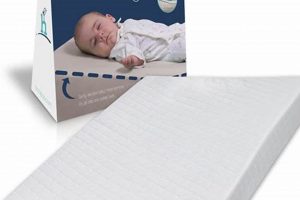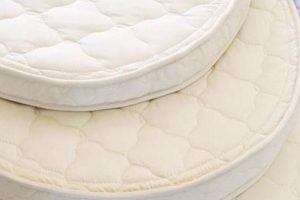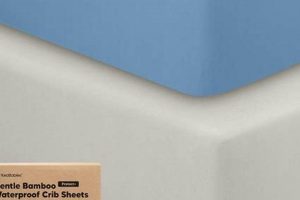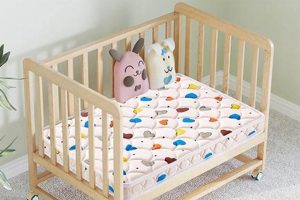An infant’s sleeping environment plays a vital role in their health and well-being. A component frequently used within a crib is a specialized covering designed to protect the mattress from spills and accidents. These coverings, when manufactured utilizing materials cultivated and processed without synthetic pesticides or fertilizers, and adhering to specific certifications, are designated as ‘organic’. These materials often include cotton, wool, or bamboo, sourced from farms meeting rigorous environmental and social standards. An example includes a quilted cotton layer bonded to a waterproof backing.
The significance of such a product lies in minimizing a baby’s exposure to potentially harmful chemicals found in conventional mattress materials and treatments. Reduced exposure to volatile organic compounds (VOCs), flame retardants, and synthetic dyes is a primary advantage. Historically, concerns regarding chemical sensitivities and allergies in infants have driven the demand for safer, more natural alternatives in bedding. Furthermore, sustainable farming practices associated with sourcing these materials contribute to environmental conservation and reduced ecological impact.
The following sections will delve into various aspects concerning selecting appropriate infant bedding. The discussion will include understanding the different types of materials used, certifications to look for when purchasing, proper care and maintenance, and considerations for ensuring a safe sleep environment for the infant. Attention will also be given to comparing various brands and features to assist in making an informed purchasing decision.
Guidance for Selecting and Maintaining an Organic Crib Mattress Pad
The selection and proper maintenance of bedding is critical for infant health. The following tips outline key considerations when choosing and caring for such items.
Tip 1: Verify Certifications. Scrutinize product labels for certifications such as GOTS (Global Organic Textile Standard) or Oeko-Tex Standard 100. These certifications ensure that the materials and manufacturing processes meet stringent environmental and safety standards.
Tip 2: Prioritize Material Composition. Opt for materials known for breathability and natural properties. Organic cotton, wool, or bamboo are suitable choices. Avoid products containing polyvinyl chloride (PVC) or polyurethane due to potential off-gassing of harmful chemicals.
Tip 3: Assess Waterproofing Methods. Examine the waterproofing layer. Ideally, it should be constructed from a food-grade polyethylene film rather than chemical coatings. Ensure the waterproof layer is securely bonded to the fabric to prevent separation and potential hazards.
Tip 4: Consider Mattress Fit. Confirm that the product fits the crib mattress snugly. A tight fit prevents gaps where a baby could become entrapped. Follow the crib manufacturer’s guidelines for mattress size and recommended accessories.
Tip 5: Establish a Regular Cleaning Routine. Implement a regular cleaning schedule. Follow the manufacturers instructions for washing and drying. Frequent washing helps to remove allergens, dust mites, and potential contaminants.
Tip 6: Avoid Harsh Cleaning Agents. Refrain from using harsh chemicals, bleach, or fabric softeners. These substances can damage the fabric and leave behind residues that may irritate the infant’s skin. Opt for gentle, fragrance-free detergents specifically designed for baby items.
Tip 7: Air Dry When Possible. While machine drying is often convenient, air drying is preferable as it minimizes shrinkage and prolongs the products lifespan. If using a dryer, select a low-heat setting to prevent damage to the waterproof layer.
By carefully considering these factors during the selection and maintenance process, parents can contribute to a safer and healthier sleep environment for their infant.
The subsequent sections will provide information on common consumer concerns and a comparison of prevalent market options.
1. Material Composition
The integrity and safety of a specialized covering for crib mattresses hinge significantly on its material composition. This component is a direct determinant of the infant’s exposure to potentially harmful chemicals, allergens, and irritants. Consequently, the choice of materials fundamentally defines whether the product can rightfully be classified as ‘organic’ and contribute to a healthy sleep environment. Conventional versions often utilize synthetic fabrics, flame retardants, and waterproof coatings containing VOCs, phthalates, and heavy metals. Conversely, coverings that adhere to organic standards prioritize naturally derived materials processed without synthetic additives.
Real-life examples demonstrate the impact of material choices. Products made with GOTS-certified organic cotton, for instance, reduce the risk of skin irritation and respiratory issues often associated with synthetic textiles. Wool possesses natural flame-resistant properties, eliminating the need for chemical flame retardants. A covering employing a waterproof layer of food-grade polyethylene, rather than PVC, mitigates exposure to harmful plasticizers. The practical significance lies in fostering a less toxic environment for the developing infant, potentially minimizing the risk of allergies, asthma, and endocrine disruption.
The selection of bedding material is inextricably linked to its overall safety and sustainability. By prioritizing organic materials, parents can reduce their child’s exposure to potentially harmful substances and support environmentally responsible manufacturing practices. Understanding the material composition empowers consumers to make informed decisions, ultimately contributing to a healthier and safer sleep environment for infants. Neglecting this aspect can undermine the very purpose of seeking an ‘organic’ option, rendering the perceived benefits negligible or even counterproductive.
2. Certification Standards
Certification standards serve as a crucial validation mechanism for products claiming to be organic, especially when related to infant items such as crib mattress coverings. These standards provide assurance that the product meets specific criteria regarding material sourcing, manufacturing processes, and chemical content, ensuring transparency and accountability within the industry.
- Global Organic Textile Standard (GOTS)
GOTS is a globally recognized certification that covers the entire supply chain, from harvesting of raw materials to environmentally and socially responsible manufacturing. For a crib mattress pad to be GOTS certified, it must contain a minimum percentage of certified organic fibers (typically 95% for “organic” labeled products) and adhere to strict criteria regarding dyes, processing aids, and waste management. This assures consumers that the item is genuinely organic and produced in an ecologically and socially sound manner. For instance, a crib mattress pad bearing the GOTS label guarantees minimal exposure to pesticides, formaldehyde, and other potentially harmful substances often found in conventionally produced bedding.
- Oeko-Tex Standard 100
While not exclusively focused on organic materials, Oeko-Tex Standard 100 certifies that a product has been tested for harmful substances, including those legally banned or regulated. This certification is valuable because it provides an additional layer of assurance that the crib mattress covering is free from chemicals known to be detrimental to health, regardless of whether the materials used are strictly organic. It also tests for substances which, while not legally banned, are known to be harmful. For example, an Oeko-Tex certified covering signifies it has been tested for allergens, carcinogenic dyes, and phthalates, reducing the risk of infant exposure to these hazardous compounds.
- Organic Content Standard (OCS)
The Organic Content Standard (OCS) verifies the presence and amount of organic material in a final product. While less comprehensive than GOTS, it provides traceability of organic content from the source to the final product, assuring consumers that they are purchasing a product with verified organic material. This certification is particularly useful when a product contains a blend of organic and non-organic materials. For example, if a crib mattress pad is made with a combination of organic cotton and conventional polyester, the OCS certification would verify the percentage of organic cotton content.
- Greenguard Gold Certification
Though not specifically an organic certification, Greenguard Gold Certification focuses on chemical emissions, ensuring that products have low VOC emissions and are safe for use indoors, especially in sensitive environments like nurseries. This certification complements organic certifications by addressing the issue of indoor air quality. A crib mattress pad with Greenguard Gold Certification signifies it has been tested and shown to emit minimal levels of VOCs, such as formaldehyde, contributing to a healthier indoor environment for the infant.
The presence of these certifications on a crib mattress pad serves as a tangible indicator of quality and safety. Consumers seeking an organic option should prioritize products bearing certifications to mitigate risks associated with harmful chemicals and unsustainable manufacturing practices. The certifications provide transparency and confidence in the product’s claims of being organic and safe for infant use. The absence of such certifications should raise concerns about the product’s true composition and the integrity of its manufacturing process.
3. Waterproof Barrier
The inclusion of a waterproof barrier is a functional necessity within an organic crib mattress pad, yet its integration presents specific challenges to maintaining the organic integrity of the overall product. The primary function of this barrier is to protect the underlying mattress from fluids, such as spills, urine, and diaper leaks, which if absorbed, could lead to bacterial growth, odors, and mattress degradation. Without an effective waterproof layer, even the highest-quality organic materials used in the mattress pad’s construction would be compromised, rendering the product unhygienic and potentially harmful to the infant. A non-organic waterproof layer negates the benefits of organic materials. For example, a pad made from organic cotton but lined with PVC would expose the infant to phthalates and other harmful chemicals.
Achieving effective waterproofing while adhering to organic principles requires careful material selection. Traditional waterproofing methods often rely on synthetic materials like PVC or polyurethane, which are known to release volatile organic compounds (VOCs). Organic alternatives include tightly woven fabrics treated with plant-based waxes or coatings, or the use of thin layers of food-grade polyethylene. These alternatives strive to balance waterproofing functionality with minimal chemical impact. Consider a mattress pad using a thin layer of polyethylene bonded to organic cotton. The polyethylene provides a waterproof barrier, while the organic cotton provides a breathable, non-toxic surface for the infant. The effectiveness of the barrier is crucial; inadequate waterproofing leads to mattress contamination, requiring frequent replacement and negating the long-term cost savings and environmental benefits associated with organic products.
In conclusion, the waterproof barrier is a critical component of an organic crib mattress pad, essential for maintaining hygiene and prolonging the mattress lifespan. The challenge lies in selecting materials that provide effective waterproofing without compromising the organic integrity of the product. The use of plant-based treatments or food-grade polyethylene offers viable solutions, balancing functionality with the need to minimize chemical exposure for the infant. Understanding the trade-offs involved in waterproof barrier selection is essential for consumers seeking truly organic and safe bedding options. Scrutinizing product labels and certifications, along with researching the specific materials used in the waterproof layer, is crucial for making informed purchasing decisions.
4. Size Compatibility
The precise fit of a crib mattress pad within a crib is not merely a matter of convenience but a critical safety concern. A covering, even one manufactured from certified organic materials, becomes a potential hazard if its dimensions do not correspond precisely with those of the crib mattress. Excess material creates gaps between the mattress and the crib frame, increasing the risk of infant entrapment and suffocation. Conversely, a covering that is too small may not adequately protect the mattress surface, compromising its hygiene and longevity. The selection of an “organic crib mattress pad” necessitates verification of its dimensions against the specific crib model to ensure a secure and functional fit. For example, a standard crib mattress measures approximately 28 inches wide by 52 inches long; a pad intended for this mattress must adhere to these dimensions within a narrow tolerance to prevent hazardous gaps.
Numerous instances exist where improperly sized bedding has contributed to infant injuries and fatalities. Reports from regulatory agencies frequently cite cases involving loose bedding, including ill-fitting mattress coverings, as a contributing factor in crib-related incidents. The practical application of this knowledge lies in meticulous measurement of the crib mattress and careful comparison with the stated dimensions of the organic mattress pad prior to purchase. Retailers and manufacturers should provide clear and accurate sizing information, and consumers bear the responsibility of verifying this information. Furthermore, the continued integrity of the fit should be monitored over time, as repeated washing and use may cause shrinkage or stretching of the covering material, potentially compromising its original dimensions. For example, after several washes, an initially well-fitting pad might shrink, exposing corners of the mattress and reducing its protective coverage.
In summary, size compatibility is an indispensable aspect of selecting and using an “organic crib mattress pad.” The pursuit of organic materials and construction must not overshadow the paramount importance of a proper fit, as the latter directly impacts infant safety. Vigilant attention to size specifications, coupled with ongoing monitoring of the pad’s fit over time, are essential steps in mitigating the risks associated with improperly sized bedding and ensuring a safe sleep environment for the infant. The purchase of organic bedding should include the dimension specifications.
5. Care Instructions
Care instructions are an indispensable component directly influencing the longevity, hygiene, and continued organic integrity of a crib mattress pad. Deviation from prescribed cleaning procedures can undermine the benefits of selecting organic materials. For instance, the use of harsh chemical detergents on an organic cotton covering may introduce harmful residues that negate the intended health advantages. Similarly, improper drying techniques, such as high heat, can damage the waterproof layer or cause shrinkage, compromising both the fit and functionality. The adherence to specified guidelines represents a critical factor in preserving the product’s safety and effectiveness over its lifespan. The proper handling of organic material is paramount.
Furthermore, adherence to care instructions directly impacts the control of allergens and microorganisms within the infant’s sleep environment. Frequent washing, as recommended by manufacturers, aids in the removal of dust mites, pet dander, and other potential allergens that may accumulate over time. However, employing excessively hot water or aggressive cleaning agents can degrade the organic fibers, reducing their breathability and potentially causing skin irritation. The care instructions are not merely suggestions but rather carefully calibrated protocols designed to maintain the delicate balance between hygiene and material preservation. Consider a scenario where a parent, aiming to thoroughly clean the pad, uses bleach; this action not only compromises the organic nature of the materials but also leaves behind potentially harmful chemical residues that the infant may inhale or absorb through the skin. Following recommendations ensures that product warranty remains.
In summary, the connection between “Care Instructions” and an “organic crib mattress pad” extends beyond simple maintenance; it represents a critical link in ensuring the continued safety, hygiene, and organic integrity of the product. The selection of an organic covering necessitates a corresponding commitment to adhering to the prescribed care protocols. Deviation from these guidelines can introduce harmful substances, compromise the product’s functionality, and ultimately undermine the intended benefits. The adherence to care instructions promotes infant health. The commitment demonstrates the responsible use of a product designed for infant wellness.
6. Chemical Absence
The defining characteristic of an “organic crib mattress pad” lies in its commitment to “Chemical Absence”. This is not merely a marketing claim but a fundamental requirement for safeguarding infant health. The developing bodies of infants are particularly vulnerable to the adverse effects of chemical exposure, as their detoxification systems are not yet fully mature. Conventional crib mattresses and their associated pads frequently contain a wide array of synthetic chemicals, including volatile organic compounds (VOCs), flame retardants (such as polybrominated diphenyl ethers or PBDEs), phthalates, and formaldehyde. These chemicals can off-gas into the infant’s sleeping environment, leading to potential respiratory irritation, allergic reactions, endocrine disruption, and even long-term health consequences. The deliberate avoidance of these substances is, therefore, the primary objective in selecting an organic alternative. The assurance of chemical absence ensures a safer sleeping environment. For example, the off-gassing of flame retardants in standard mattresses has been linked to neurodevelopmental issues in some studies, highlighting the importance of choosing chemically inert bedding.
The pursuit of “Chemical Absence” in an “organic crib mattress pad” necessitates rigorous material sourcing and manufacturing processes. Certified organic cotton, wool, or latex are typically employed, cultivated and processed without the use of synthetic pesticides, herbicides, or fertilizers. Furthermore, any dyes or finishes must be derived from natural sources and free from heavy metals or other toxic substances. Waterproofing, if required, should be achieved through the use of food-grade polyethylene or other inert materials, rather than PVC or chemical coatings. The practical application of this principle manifests in the selection of products bearing certifications such as GOTS (Global Organic Textile Standard) or Oeko-Tex Standard 100, which independently verify the absence of harmful chemicals and adherence to strict environmental standards. Consider the case of a crib mattress pad made with conventional cotton and a polyurethane waterproof layer; this product, while seemingly functional, would expose the infant to a cocktail of potentially harmful chemicals, negating any perceived benefits of its design. A safe environment is created by certified products.
In conclusion, the principle of “Chemical Absence” is the cornerstone of an “organic crib mattress pad”, differentiating it from conventional alternatives and serving as a crucial safeguard for infant health. While the pursuit of organic materials represents a significant step, it must be accompanied by a comprehensive understanding of the potential chemical hazards associated with mattress pads and a commitment to selecting products that have been rigorously tested and certified to be free from these harmful substances. The challenge lies in navigating the complexities of product labeling and certification, as well as remaining vigilant against greenwashing tactics employed by some manufacturers. The ultimate goal remains the creation of a safe, healthy, and non-toxic sleeping environment for the infant, fostering optimal development and well-being. Absence of dangerous chemicals should be top priority when choosing a product.
Frequently Asked Questions
The following section addresses common inquiries and concerns regarding organic crib mattress pads. The information aims to provide clarity and assist in making informed decisions.
Question 1: What defines a crib mattress pad as “organic”?
A crib mattress pad is typically considered “organic” when it is constructed from materials grown and processed according to organic agricultural standards. These standards generally prohibit the use of synthetic pesticides, herbicides, and fertilizers. Independent certifications, such as GOTS (Global Organic Textile Standard), verify adherence to these standards throughout the entire supply chain.
Question 2: Why choose an organic crib mattress pad over a conventional one?
The primary benefit of selecting an organic crib mattress pad is to reduce infant exposure to potentially harmful chemicals commonly found in conventional bedding. These chemicals may include volatile organic compounds (VOCs), flame retardants, and synthetic dyes. Minimizing such exposure is considered a precautionary measure for infant health and well-being.
Question 3: Are organic crib mattress pads inherently waterproof?
Not all organic crib mattress pads are inherently waterproof. Waterproofing is often achieved through the addition of a barrier layer. When selecting an organic pad, it is important to investigate the materials used in the waterproof layer. Options such as food-grade polyethylene are preferable to PVC or other chemical-based coatings. The organic certification covers the materials it contains.
Question 4: How should an organic crib mattress pad be cleaned and maintained?
Care instructions vary depending on the specific materials used in the crib mattress pad. Generally, gentle detergents free from harsh chemicals or dyes are recommended. Machine washing on a delicate cycle and air drying or tumble drying on a low heat setting are typically appropriate. Adhering to the manufacturer’s instructions is crucial for preserving the integrity of the organic materials.
Question 5: What certifications should one look for when purchasing an organic crib mattress pad?
Certifications such as GOTS (Global Organic Textile Standard) and Oeko-Tex Standard 100 are widely recognized and provide assurance that the product meets specific standards regarding organic content and the absence of harmful substances. These certifications offer a degree of independent verification and transparency.
Question 6: Do organic crib mattress pads offer any specific advantages regarding infant allergies?
While an organic crib mattress pad cannot guarantee the prevention of allergies, the absence of synthetic chemicals and allergenic dyes may reduce the risk of allergic reactions in some infants. Selecting materials known for their hypoallergenic properties, such as organic cotton or wool, may further minimize potential sensitivities.
In summary, choosing an organic crib mattress pad involves careful consideration of materials, certifications, and care instructions. The primary objective is to minimize infant exposure to potentially harmful chemicals and create a safer, healthier sleep environment.
The next section will compare various brands and models of organic crib mattress pads currently available on the market.
Conclusion
The preceding discussion has explored multiple facets of the organic crib mattress pad. Emphasis has been placed on material composition, certification standards, waterproofing methods, size compatibility, proper care, and the critical absence of harmful chemicals. Selection of such a product requires careful consideration of these elements to ensure a safe and hygienic sleeping environment for the infant.
The decision to invest in an organic crib mattress pad reflects a commitment to infant well-being and environmental responsibility. Continued research and development in material science and manufacturing processes are essential to further enhance the safety, efficacy, and sustainability of these products. Vigilance in verifying certifications and adhering to recommended care guidelines remains paramount in realizing the intended benefits. The ultimate aim is to provide the infant with a sleeping environment as free as possible from potentially harmful substances.







![Best Crib Mattress Bed Frame [Guide] for Babies Organic & Natural Mattress Buyer’s Guide: Non-Toxic Sleep Solutions Best Crib Mattress Bed Frame [Guide] for Babies | Organic & Natural Mattress Buyer’s Guide: Non-Toxic Sleep Solutions](https://mattressworldpa.com/wp-content/uploads/2025/07/th-1293-300x200.jpg)